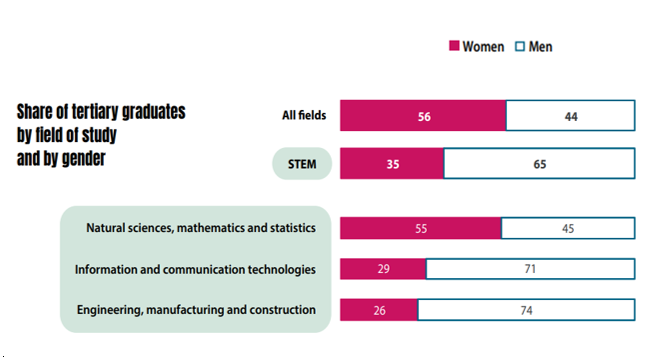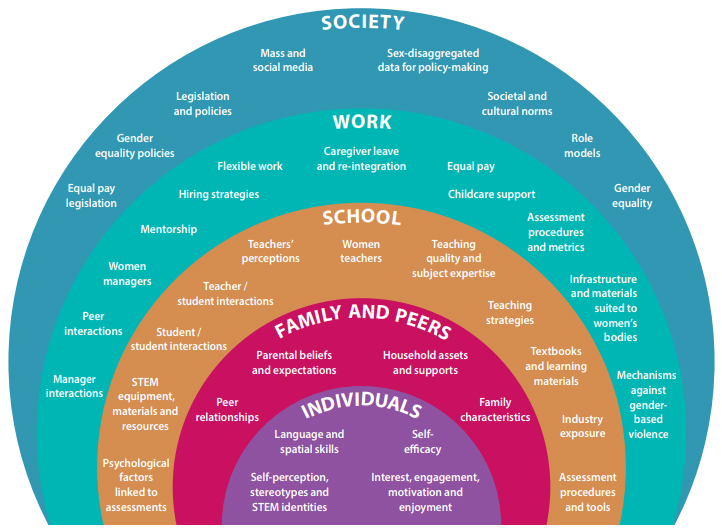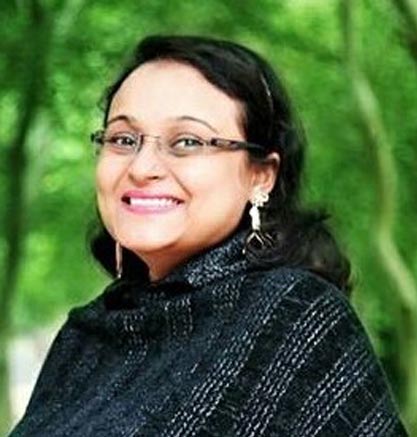-
CENTRES
Progammes & Centres
Location
The gender gap in STEM careers persists despite various initiatives. More effective strategies are needed to promote gender equity and foster an inclusive environment.

Image Source: Getty
The International Day of Women and Girls in Science, celebrated on 11th February, serves as a poignant reminder of the need to address the gender gap in science and technology education while calling for greater participation of women in STEM (Science, Technology, Engineering and Mathematics) careers to create a more diverse and inclusive workforce. Increasing women's participation in STEM is essential as future jobs are likely to become increasingly tech-driven. STEM skills are, therefore, key to ensuring long-term career stability and can play a crucial role in closing the gender pay gap. Empowering women not only benefits individuals but also unlocks diverse perspectives and untapped potential, which are crucial for addressing global challenges such as poverty alleviation, skilled labour shortages, and sustainable innovation—all of which drive economic growth.
Increasing women's participation in STEM is essential as future jobs are likely to become increasingly tech-driven.
Gender parity in education—measured by the proportion of girls enrolled per hundred boys—has seen some steady progress over the last two decades in most countries. Yet, gender disparities in performance continue to persist and begin from a young age, particularly in STEM subjects. The 2022 Programme for International Student Assessment (PISA) Survey found that boys had an average advantage of 9 points in mathematics, a gap which has been constant since 2015, despite considerable regional variation. Likewise, Trends in International Mathematics and Science Study (TIMSS), 2019 revealed that the gender gap in mathematics was evident as early as the fourth grade. Even in countries where girls performed at par or even better than boys in maths, boys are over-represented among the top performers. Although the gender gap is less pronounced in science, girls generally perform better and have more confidence in biology, compared to subjects like physics. Further, boys were much more likely to express a desire to pursue STEM in higher education and careers as compared to girls. This trend has been recorded in several studies conducted across different regions.
In tertiary education, women account for 35 percent of STEM graduates—a figure that has not changed over the last decade. Within STEM, women workers congregate largely in care-related jobs (mainly nursing) but remain underrepresented in job clusters related to physical sciences, computing and engineering (see Figure 1).
Figure 1: Tertiary graduates in STEM by the field of study and gender

Source: Changing the Equations, Securing STEM Futures for Women, UNESCO, 2024
In G20 countries, women hold only 22 percent of the total STEM jobs. In eight of ten G20 countries where data was available, women’s pay was less than 85 percent of men’s pay in STEM occupations. Noting several other gender-related disadvantages, UNESCO states that women researchers had shorter and less lucrative careers where they received smaller research grants than their male colleagues and were often passed over for leadership positions. Hispanic and Black women have further low participation, with a higher pay gap.
Women and girls continue to face systemic barriers in advancing through higher education and the career ladder, reinforcing gender disparities in STEM.
Therefore, despite more girls entering classrooms, these educational gains are not adequately translated into meaningful career gains. Women and girls continue to face systemic barriers in advancing through higher education and the career ladder, reinforcing gender disparities in STEM.
A systematic review of 165 studies published between 2013 and 2023 categorises the factors affecting girls’ participation in STEM as personal, environmental, and behavioural. Of these, environmental factors like cultural expectations, no access to STEM equipment, lack of female role models and such are attributed by over 60 percent of studies. Only 17 studies (about 10 percent) attribute girls’ low participation in STEM subjects due to personal factors like poor interest and negative attitudes.
Similarly, UNESCO’s Gender Scan Survey discuss factors at five levels that affect the participation of women and girls in STEM. These include: individual, family and peer, school, workplace and societal level factors (see Figure 2).
Figure 2: Framework of factors influencing and women and girls in STEM

Source: Changing the Equations, Securing STEM Futures for Women, UNESCO, 2024
At the individual level, self-beliefs, perceptions and social experiences affect STEM-related learning and performance in girls. Family and peers shape beliefs, motivation and aspirations, where gendered expectations can reduce girls’ sense of belonging in STEM. In schools, factors like curricula, learning materials, teaching strategies, student-teacher interactions, and assessment practices influence whether girls pursue STEM careers. Workplace-level factors including hiring and promotion practices, flexibilities for work-life balance, mechanisms for addressing gender-based harassment and violence, affect if women who enter the STEM workforce continue and grow in their careers. Finally, overall social and cultural norms, roles and status prescribe what support girls need for learning and working in STEM fields. Although policy interventions can offer support and compensate for these factors, too many women continue to be held back by these factors.
Achieving gender parity in STEM requires a multi-faceted approach that include targeted policy interventions, curriculum reforms, teacher training, mentorship, and community engagement. These strategies address various factors contributing to the gender gap in STEM, from early childhood to career advancement.
TeachGirls in the United States, Girls Who Code in India and Girls Go Circular are all successful examples of educational programmes that encourage, guide and train girls.
A primary intervention is to enhance low self-efficacy in girls by early exposure to STEM activities and hands-on learning experiences that build interests and confidence before stereotypes take hold. TeachGirls in the United States, Girls Who Code in India and Girls Go Circular are all successful examples of educational programmes that encourage, guide and train girls. Indigenous Girls’ STEM Academy in Australia is a unique programme that offers targeted support to indigenous girls, encouraging them to aspire for education and careers in STEM professions.
The 2021 Gender Scan Survey found that relatives, friends and teachers primarily influenced study and career choices. Role modelling and mentorship programmes can, therefore, provide invaluable direction and inspiration. Several countries offer mentorship programmes, for instance, STEM4ALL x Mentoring Her in Kazakhstan and India’s Vigyan Jyoti Programme, which prioritise female participation by integrating science and engineering into core education. An evaluation of the online mentoring programme in Germany, CyberMentor, found that in just one year of e-mentoring, there was a 50 percent increase in knowledge and confidence in STEM among participants.
Curriculum and pedagogical reforms promoting inclusivity for girls in STEM have demonstrated a significant impact. For example, the National Girls Collaborative Project (NGCP) in the U.S. connects organizations to enhance STEM opportunities for girls, reaching approximately 20 million participants since 2002. Additionally, Girlstart focuses on hands-on STEM experiences for girls, encouraging exploration in a supportive environment. Programmes by the European Union like Scientix, Hypatia Project and Erasmus+ FMEST initiatives have shown that gender-sensitive curricula and relevant teaching methods can effectively engage girls in STEM, breaking down stereotypes and promoting participation.
Another set of programmes focuses on facilitating the transition from classroom to careers for women in STEM or supporting their re-entry after familial breaks. These initiatives also provide scholarships, internships or apprenticeship opportunities while promoting inclusive workplaces to combat discrimination. Some examples include TechWomen (US), Women in STEMM (Australia), and KIRAN (Knowledge Involvement in Research Advancement through Nurturing, India).
Systematic interventions to change public perceptions and workplace conditions in STEM are few, and therefore, institutional-level barriers persist and remain largely intact.
Despite these programmes, progress has been insufficient, and gender gaps persist. This is because, firstly, these programmes and interventions have usually been undertaken on a small scale and have not been accessible to women and girls across socio-economic groups. Secondly, it is a complex issue that cannot be solved by intervening at the level of individuals (girls) alone. Systematic interventions to change public perceptions and workplace conditions in STEM are few, and therefore, institutional-level barriers persist and remain largely intact.
Data pertaining to the educational enrolment and performance of women and girls in STEM is not enough. To drive meaningful change, we need better insights into the experiences of women pursuing STEM careers to bring about qualitative changes in their lives. Lastly, there is a pressing need for improved tracking and data collection to inform policy decisions effectively. By establishing comprehensive metrics that capture the full spectrum of women's experiences in STEM, policymakers can develop more effective strategies that promote gender equity and foster an inclusive environment in the field.
Arpan Tulsyan is a Senior Fellow with the Centre for New Economic Diplomacy at the Observer Research Foundation.
The views expressed above belong to the author(s). ORF research and analyses now available on Telegram! Click here to access our curated content — blogs, longforms and interviews.

Arpan Tulsyan is a Senior Fellow at ORF’s Centre for New Economic Diplomacy (CNED). With 16 years of experience in development research and policy advocacy, Arpan ...
Read More +